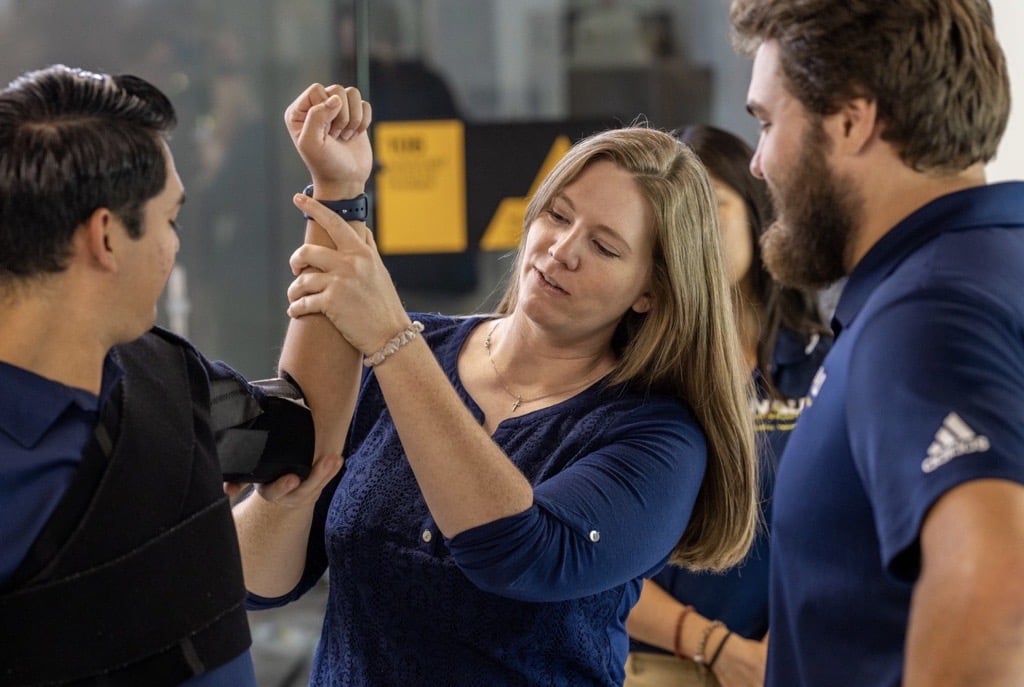Megan Mulready is an assistant clinical professor and assistant coordinator of clinical education in the Department of Physical Therapy and Athletic Training at NAU. While she was a student, she did an internship with the Arizona Diamondbacks, currently playing in the World Series against the Texas Rangers. Read more about her experience below.
There are a few experiences that most people can remember as being impactful, memorable and formative—a new job, a first trip involving a passport, a move across country. For me, it was my final clinical residency with the Arizona Diamondbacks while pursuing my Master of Athletic Training (MSAT) degree at the University of Idaho.
Athletic trainers play an integral role in baseball. They are the healthcare professionals in the dugout, on the field and in the clubhouse, ready to respond and provide care as needed. ATs are the first line of defense for everything from minor injuries to those that are possibly life-threatening. Athletic trainers provide preventative care and programming to enhance their players’ ability to perform at their highest level. In the event of an injury, athletic trainers are there to evaluate, refer and rehabilitate their players to return to play with the goal of performing at a higher level than prior to their injury. With the Diamondbacks, I worked closely with the athletic trainers, physical therapists and the strength and conditioning coaches to observe, practice and improve my clinical skills. I was introduced to a culture of accountability and commitment—to one’s education, experience and skill development. And while I hadn’t yet solidified my own clinical philosophy, I knew I was working with the best people that could help me to develop it. I was challenged and supported in equal measure.
One day about midway through my second month at this rotation, after I made my way to Salt River Fields, the spring training facility, and put down my belongings in the physician’s office, I touched base with my clinical preceptor, the major and minor league medical administrator. He let me know that one player would be my focus that day and for the foreseeable future. This athlete, a position player, had fractured both sides of his mandible (jawbone), after being struck by a fastball. It was a gruesome injury—being hit by a rock-hard ball coming at nearly 100 miles per hour. This athlete was not only in pain, but he was also frustrated, and understandably so—his jaw was wired shut after undergoing surgery. Alongside my preceptor, we led him through therapy sessions to reduce swelling and manage pain. With each exercise, he would progress slowly and maintain a positive attitude as best he could. He had trouble communicating, and he was visibly frustrated when he couldn’t say or express what he wanted to due to pain and restricted ability to move his jaw.
I recognized one day that he had become resigned to the routine of treatment, and I felt that some human connection was lost during this time. I decided to speak to him in a way that I believed might make him laugh. I found myself speaking to him with my jaw clenched, mimicking his tooth-gritting voice. He looked shocked. Oh no, I thought. That was it. I messed up. What was I thinking? I was sure I was packing my bags that day.
But, to my surprise, he laughed. From that moment on, our daily therapy sessions were lighter, and he visibly enjoyed coming in to check in and receive treatment. In fact, we had fun. The following weeks, he made immense progress, and I discovered my own clinical philosophy. I could be me! I could be positive, fun, sarcastic AND make a difference for the athlete. I recognized that treating patients didn’t have to be so formal, even in the professional setting. These world-recognized athletes are human beings like everyone else. I remember my preceptor provided me with feedback that the player enjoyed “making fun” of me, and it brought him joy to have this banter during his treatment and rehab. This was the first moment that I experienced what I had hoped to when I started my AT journey—I could make a lasting impact on another person, something I am thrilled to continue to do today.
As the Arizona Diamondbacks are on the biggest stage in baseball, being one of two teams to make it to the World Series this year, I of course think of the athletes ready to take the field, excited and prepared for a fight. But mostly my mind, and my heart, is with the ATs as they ready themselves for any outcome, injury or incident, supporting the team with all they have from behind the scenes. I know I will be watching and rooting for my Diamondbacks this year and for all the years ahead.



